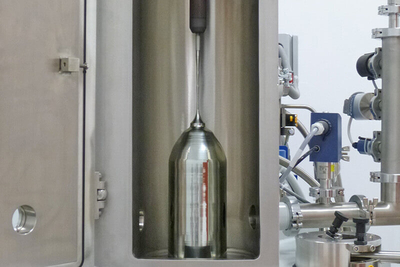Our industrial crystal-growing systems are designed for the production of ultrapure single crystals that help above all the solar and semiconductor industries as well as the R&D sector to both manufacture and continuously refine and enhance innovative products. Differing base materials are recommended depending on requirements.

Silicon is not only one of the basic elements of our planet, but also the basis for today’s information society. Without the development of silicon transistors, electronic technology as we know it today would have been unthinkable. Transistors like these are possible only thanks to the outstanding properties and stability of silicon and its oxide. The process of producing this valuable commodity, which is widely used above all in the semiconductor, solar, and polysilicon industries along with in R&D, is extremely complex and laborious.
- Silicon in detail
To obtain pure silicon, the oxygen contained in the silica sand (SiO2) has to be extracted with the help of carbon. Since silicon and oxygen are atomically very closely related, carbon and oxygen in silica sand bind to form carbon dioxide only at very high temperatures of around 1,800 °C. The carbon dioxide is discharged, leaving only the silicon. This process is extremely energy-intensive, requiring around 14 kWh per kilogram of raw silicon. Raw silicon extracted in this way still contains around 1% contamination. Industrial applications, however, require a degree of purity of at least 0.0000001% (1 ppb), which means that raw silicon is still unsuitable for computers or photovoltaic applications. For this reason, it undergoes further processing in which pure hydrochloric acid is used to convert the raw silicon to trichlorosilane, a liquid that has a boiling point of around 30 °C and is distilled in large systems more than 30 meters high. This distillate—i.e. the purified silicon—contains less than 1 ppb of contamination. The distillate is restored to solid silicon through the reaction of trichlorosilane with high-purity hydrogen. Here, a gas mixture is brought into contact with hot slim rods made from high-purity silicon onto which new silicon is deposited as polysilicon in a disordered arrangement of small crystals. The rods become increasingly thick, and, when they reach a diameter of around 180 mm, the process ends, and the rods break up into tiny pieces. With that, the material that keeps our high-tech civilization moving is ready.
Our system turns ultrapure base materials into even purer crystals. It is the perfect base material for both the Czochralski (Cz) and Float-Zone (FZ) processes.
About Our Machines:

Compared with pure semiconductor Slicon, the compound semiconductor Silicon Carbide offers more than just superior semiconductor properties. The valence–conduction band gap is three times bigger, which helps to reduce switching losses by 90%. Silicon-Carbide-based high-performance components exhibit efficiency levels close to 100%. At the same time, they can transfer much higher current densities. The semiconductor industry and R&D sector above all benefit from these positive properties.
- Advantages of silicon carbide
Silicon carbide (SiC) as a basic material for electrical components is being used more and more frequently in electromobility applications. SiC-based components are characterized by their high temperature tolerance combined with high switching efficiency and excellent thermal conductivity.
This means that technical cooling measures can either be completely eliminated or at least greatly reduced. This leads to space-saving and significantly more compact designs for high-performance power electronics components.
Also due to its high hardness, silicon carbide has been used for several decades as a technical ceramic in plain bearings, pumps and burners.
High-performance production systems such as SiCube or SiCma from PVA Crystal Growing Systems GmbH can produce the required volume of high-purity Silicon-Carbide crystals in a reproducible and efficient manner. Many experts expect the current market volume to increase many times over by 2022. This optimism is based on the fact that rapidly growing markets such as renewable power generation, electromobility, and lighting technology depend on Silicon Carbide.
About Our Machines:

Germanium was once the primary semiconductor material used in the electronics industry until it was eventually superseded by Silicon. Today, it is used in high-frequency technology (e.g. as an SiGe compound semiconductor) and detector technology (e.g. as an X-ray detector). Germanium wafers are sometimes used as substrates for solar cells made from Gallium Arsenide (GaAs). The lattice parameter of Germanium is very similar to that of Gallium Arsenide, which means that GaAs can grow epitaxially on Germanium single crystals. In the future, Germanium could become increasingly important again thanks to new Germanium–Carbon–Silicon technology.
Germanium is ideal for use in our Czochralski systems such as the CGS-Lab, which can pull germanium crystals used primarily in the semiconductor industry.
About Our Machines:

Compound semiconductors in main groups III and IV offer one key advantage over Silicon: Their band gaps can be varied simply by changing the material composition, which means that their electrical properties can be selectively altered. For this reason, they are used primarily in technical applications such as optical instruments, LEDs and lasers. Some bonds also have a direct quantum transition, which makes them ideal for use in optical applications, too.
In our Kronos system – based on the Vertical Gradient Ffreeze (VGF) method - compound semiconductors such as Indium Phosphide (InP) and Gallium Arsenide (GaAs) are produced
About Our Machines:
